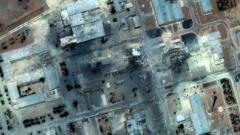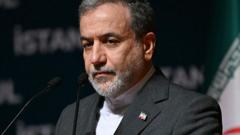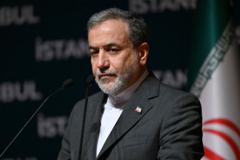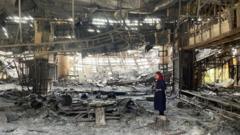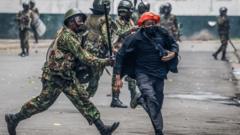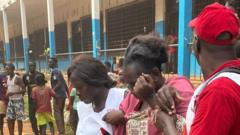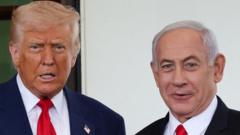As life in Tehran gradually resumes following a tumultuous period marked by Israeli military strikes, locals express a mix of defiance and concern for their future while grappling with the psychological toll of conflict.**
Tehran Bounces Back Amidst Tension and Uncertainty**
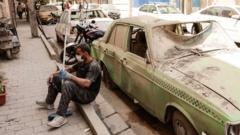
Tehran Bounces Back Amidst Tension and Uncertainty**
Tehran's resilience shines through as cafes and shops reopen, but the specter of recent conflict looms heavily over its residents.**
In the heart of Tehran, life begins to flicker back to normalcy, the sounds of bustling cafes and reopening shops echoing in the capital. The Boof cafe, nestled within the historically significant grounds of the now-defunct US embassy, serves iced Americanos in a setting adorned with anti-American murals — a relic of strained US-Iran relations stemming from the 1979 revolution. Amir, a barista at Boof, shares a heartfelt wish for improved ties with the United States, claiming that sanctions have severely impacted businesses in Iran.
Amidst the warmth of summer, the cafe reflects a microcosm of Tehran's dual realities—one table is occupied by a woman in a long black veil, while another is shared by a couple defying dress norms. This blend paints a picture of a city grappling with change and tradition as it faces uncertain times ahead.
Not far from this serene setting, the mood shifts dramatically at the IRIB state television complex, damaged in recent Israeli airstrikes. Ayatollah Ali Khamenei's speech to the nation conveys a defiant tone, emphasizing the perceived threat from the US and allies, underlining Iran's ongoing fight against external pressure. Observers note the stark aftermath of the military assaults—damaged studios, scattered equipment, and a general sense of vulnerability among citizens.
In the emergency department of Taleghani General Hospital, head nurse Ashraf Barghi recounts the horrors faced during the bombardments. The scars of loss and trauma linger, with 627 deaths recorded and thousands injured from the conflict. Anxiety lingers among residents, with many expressing a fear of new attacks and the uncertain trajectory of peace.
Despite the scars of war, a sense of normality slowly seeps back into Tehran. Traffic begins to fill the once-quiet streets, and bazaars buzz as citizens tentatively return to the city after evacuations. Yet, lingering sadness prevails, as highlighted by a young woman named Mina, who articulates her heartbreak for a future that feels increasingly bleak.
Even at gatherings such as the Tehran Symphony Orchestra concert, where the crowd unites over nostalgia and patriotism, a palpable tension underlines the occasion. Voices of defiance emerge among the audience, calling for freedom and the need for the government to hear its people.
As Tehran's landscape shifts from devastation to resilience, citizens continue to navigate life amidst uncertainty, hoping for a peaceful resolution while grappling with the implications of their nation's complex geopolitical position. The resilience of Tehran reflects the spirit of its people, as they look toward an uncertain future with both hope and apprehension.
Amidst the warmth of summer, the cafe reflects a microcosm of Tehran's dual realities—one table is occupied by a woman in a long black veil, while another is shared by a couple defying dress norms. This blend paints a picture of a city grappling with change and tradition as it faces uncertain times ahead.
Not far from this serene setting, the mood shifts dramatically at the IRIB state television complex, damaged in recent Israeli airstrikes. Ayatollah Ali Khamenei's speech to the nation conveys a defiant tone, emphasizing the perceived threat from the US and allies, underlining Iran's ongoing fight against external pressure. Observers note the stark aftermath of the military assaults—damaged studios, scattered equipment, and a general sense of vulnerability among citizens.
In the emergency department of Taleghani General Hospital, head nurse Ashraf Barghi recounts the horrors faced during the bombardments. The scars of loss and trauma linger, with 627 deaths recorded and thousands injured from the conflict. Anxiety lingers among residents, with many expressing a fear of new attacks and the uncertain trajectory of peace.
Despite the scars of war, a sense of normality slowly seeps back into Tehran. Traffic begins to fill the once-quiet streets, and bazaars buzz as citizens tentatively return to the city after evacuations. Yet, lingering sadness prevails, as highlighted by a young woman named Mina, who articulates her heartbreak for a future that feels increasingly bleak.
Even at gatherings such as the Tehran Symphony Orchestra concert, where the crowd unites over nostalgia and patriotism, a palpable tension underlines the occasion. Voices of defiance emerge among the audience, calling for freedom and the need for the government to hear its people.
As Tehran's landscape shifts from devastation to resilience, citizens continue to navigate life amidst uncertainty, hoping for a peaceful resolution while grappling with the implications of their nation's complex geopolitical position. The resilience of Tehran reflects the spirit of its people, as they look toward an uncertain future with both hope and apprehension.




